
* Our Milky Way Galaxy is only one of countless numbers of galaxies in the entire Universe. This chapter provides a short discussion of galaxies beyond the Milky Way.
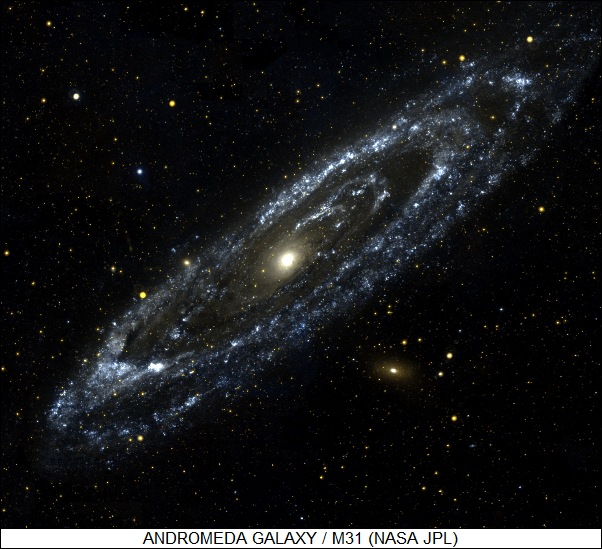
* The discovery of other galaxies in the Universe led to the discovery of vast numbers of such objects. Astronomers quickly recognized that galaxies took on a number of common forms, allowing them to be categorized as "ellipticals", "spirals", "barred spirals", "lenticulars", and "irregulars":
Galaxies with unusual and puzzling features are sometimes given a secondary classification as "peculiar". For example, an "Sb (pec)" galaxy would be a spiral with some disruptive feature. Some of the peculiar features seem to be due to highly energetic activities.
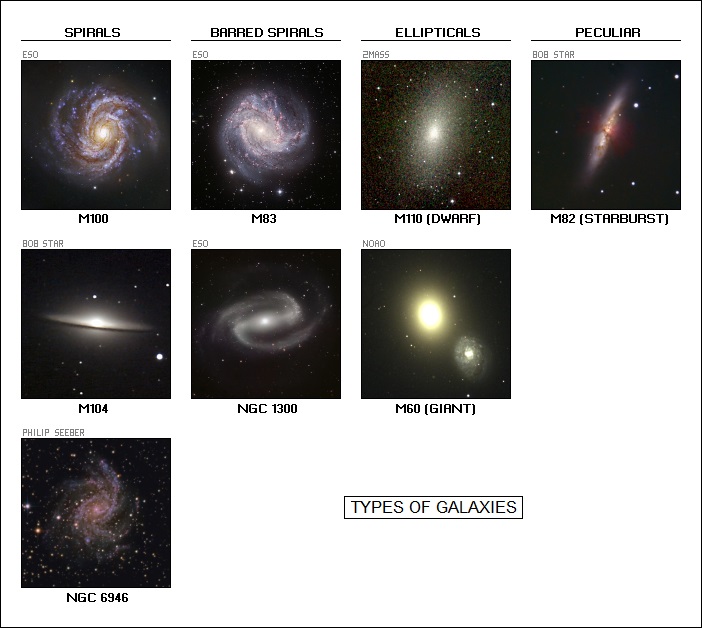
Many galaxies have active cores. In 1971, astrophysicists Martin Rees (born 1942) and Donald Lynden-Bell (1935:2018) suggested that supermassive black holes, with a mass of about a million Suns, would be able to produce such levels of activity from an inflow of mass. As mentioned previously, there seems to be a supermassive black hole in the center of the Milky Way, though it is relatively quiet for the time being.
Galaxies with active cores produce a lot of energy and throwing out huge cosmic jets from the galactic poles. Active galaxies include the "Seyfert galaxies", "radio galaxies", and "blazars". These classifications are in addition to their structural classification as spirals or ellipticals.
These three types of active galaxies seem to be the same sort of thing seen from different perspectives. In a Seyfert galaxy, we can see the active core directly. In a radio galaxy, we are seeing the galaxy edge on and cannot see the core itself, but we can detect the big cosmic jets pouring out from the poles. A blazar is turned at a right angle to put us in the boresight of a cosmic jet, making the source seem extremely energetic. The blazar fluctuates rapidly in much the same way that a cosmic jet seen from another angle fluctuates.
Other galaxies with active cores seem to be undergoing rapid star formation or "starbursts" in the core region, creating many bright stars which then quickly grow old and die in supernovas. The supernova shells then help heat up the interstellar dust and gas in the core, making it even brighter. Such starburst galaxies seem to be undergoing collisions that cause rapid star formation. One such relatively nearby starburst galaxy, M82, has such a chaotic center that it was once thought to be exploding. In a sense it may be, but not in one big explosion. It is suspected that it was forced into starburst activity by a close pass of its larger neighbor, the pretty spiral galaxy M81, which set up tidal stresses through the smaller galaxy that led to rapid star formation.
BACK_TO_TOP* The Milky Way is part of a gravitationally-bound association of galaxies called the "Local Group (LG)". The LG has two major galaxies, including the Milky Way and the Andromeda Galaxy, which are about 2.2 million light-years apart. The Andromeda Galaxy is about 1.5 times the diameter of the Milky Way and twice as massive. Interestingly, the Andromeda Galaxy's spin opposes that of the Milky Way, suggesting that they were formed together as two contra-rotating whirlpools of gas.
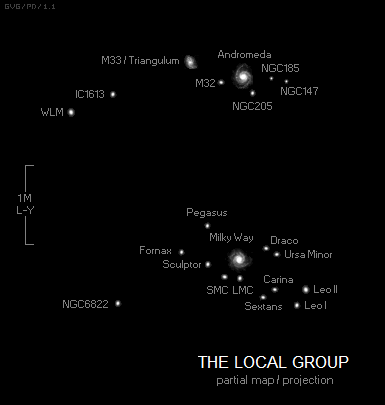
The Andromeda Galaxy has a fairly substantial neighbor, the loose spiral galaxy "M33" or "Triangulum", which is about half the diameter of the Milky Way. M33 is about 700,000 light-years from the Andromeda Galaxy and also about 2.2 million light-years away.
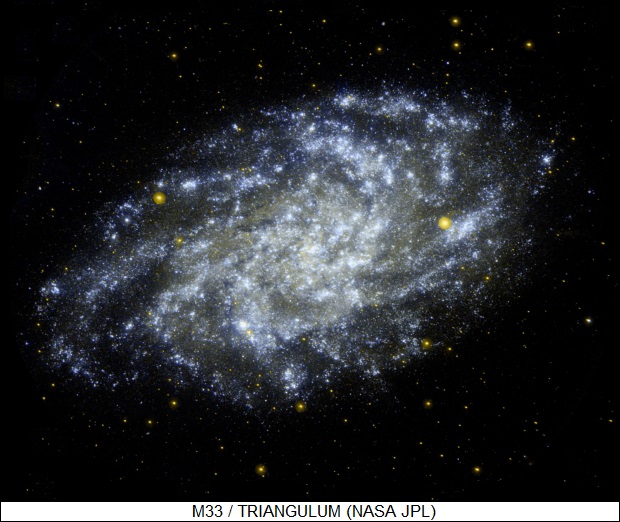
The LG includes the Milky Way's two relatively small companion galaxies, the Large Magellanic Cloud (LMC) and the Small Magellanic Cloud (SMC), both of which have already put on appearances in this document. The LMC is about 160,000 light-years away, while the SMC is about 200,000 light-years away. There is also a smattering of one to two dozen dwarf galaxies in the LG. All these dwarf galaxies combined make up less than a tenth of the total mass of the LG.
THE LOCAL GROUP
___________________________________________________________
distance diameter luminosity type
___________________________________________________________
Milky Way - 100,000 14,000 spiral
Sagittarius 78,000 15,000 30 elliptical
LMC 160,000 30,000 2,000 irregular
SMC 190,000 20,000 250 irregular
Ursa Minor 225,000 1,000 0.3 elliptical
Draco 248,000 500 0.3 elliptical
Sculptor 250,000 1,000 1.5 elliptical
Carina 280,000 500 0.4 elliptical
Sextans 290,000 1,000 0.8 elliptical
Fornax 430,000 3,000 20 elliptical
Leo II 750,000 500 1 elliptical
Leo I 880,000 1,000 10 elliptical
Phoenix 1,270,000 1,000 0.8 irregular
NGC6822 1,750,000 8,000 300 irregular
And II 1,910,000 2,000 5 elliptical
NGC147 1,920,000 10,000 80 elliptical
NGC185 2,000,000 6,000 110 elliptical
Andromeda 2,500,000 150,000 40,000 spiral
M32 2,500,000 5,000 300 elliptical
NGC205 2,500,000 10,000 250 elliptical
M33 2,500,000 40,000 4,000 spiral
IC1613 2,500,000 12,000 80 irregular
LGS 3 2,500,000 1,000 0.6 irregular
And I 2,570,000 2,000 5 elliptical
And III 2,570,000 3,000 1 elliptical
EGB0427+63 2,600,000 1,000 0.8 elliptical
Tucana 2,900,000 500 0.6 elliptical
WLM 3,000,000 7,000 30 irregular
SagDIG 3,700,000 5,000 2 irregular
IC10 4,000,000 6,000 1,000 irregular
Pegasus 5,800,000 7,000 50 irregular
___________________________________________________________
distance and diameter are in light-years
luminosity is in millions of Suns
* The Magellanic clouds are relatively nearby, and so objects of considerable interest. While the Magellanic Clouds are sometimes referred to as "dwarf" galaxies, they are actually of medium size. They are substantially smaller than the Milky Way, but the Milky Way is unusually large as spiral galaxies go. The LMC has a diameter about half that of the Milky Way, about 50,000 light-years, about a tenth of the mass, and about a seventh of the brightness. The SMC has about a third of the diameter of the Milky Way, about a fortieth of the mass, and about a twenty-fifth of the brightness.
They are both irregular galaxies, with a faint bar at the center but no nucleus, and the two are loosely connected together by a "bridge" of gas. The LMC has a very subtle spiral-like structure and appears to be a badly warped disk. The SMC is chaotic, regarded as a "peculiar" irregular galaxy, since it doesn't fit neatly into any established category. Observations show that the SMC actually consists of two galaxies that just happen to lie along our line of sight, which contributes to the confused appearance. The larger of the two components is still called the SMC, while the smaller is sometimes called the "Mini-Magellanic Cloud (MMC)".
Both the LMC and SMC are studded with very young, big, blue stars that are each about a million times more luminous than our Sun. Many of these bright stars are surrounded by emission nebulas, and in fact the LMC contains the biggest known emission nebula, designated "30 Doradus" and known as the "Tarantula Nebula" for its spidery appearance. If it were as close to our Sun as the Orion Nebula, the best-known emission nebula in our neighborhood, it would be about as bright as the full Moon. Of course, the Magellanic Clouds have far more stars of lower mass and luminosity, with many collected into globular clusters.
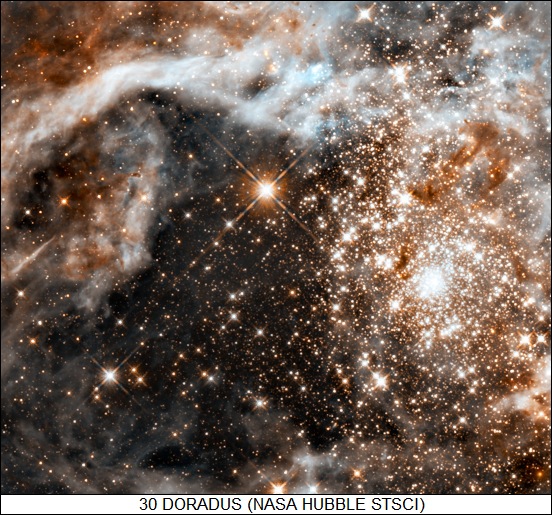
It is likely that the Magellanic Clouds were formed at about the same time as the Milky Way, but since they were smaller than the Milky Way the collapse was not as complete, with the clouds remaining mostly gaseous. They still are gas-rich compared to the Milky Way. While the Milky Way is only about 2% un-ionized hydrogen (H-I) by mass, the LMC is about 10% and the SMC is about 30%. This is still a much smaller proportion than in the past. About two billion years ago, something triggered a wave of star formation in the clouds.
The past and future history of the Magellanic Clouds remains a matter of debate. It is unclear if they have always been in orbit around the Milky Way, or if they arrived from deep space and were captured by it. It is believed that the Magellanic Clouds will eventually collide with the Milky Way and be absorbed. The collision will produce a rapid burst of star-forming that could increase the brightness of the Milky Way by about 25%. There is indirect evidence that the Milky Way has absorbed other small galaxies in the past. The stars obtained by the Milky Way from such galaxies tend to follow similar orbits and have similar compositions, and astronomers have identified such associations in our Galaxy.
Most of these absorption events took place long ago, depleting the region around the Milky Way of dwarf galaxies. In 2003, several astronomers announced the discovery of what appears to be a relatively tidy ring of stars around the plane of the Milky Way that may have been created by the absorption of a satellite galaxy about ten billion years ago. Such "ring galaxies" have been observed in the distant Universe, and are believed to be the result of a large galaxy absorbing a smaller neighbor.
As the prospect of the future absorption of the Magellanic Clouds shows, the process still goes on at a lower rate. In fact, in 1994 a dwarf galaxy ten thousand times smaller than our own was discovered from radio observations in the direction of Sagittarius, the center of the Milky Way, meaning the newly discovered dwarf was on the other side of the galactic disk. The Milky Way is now in the process of swallowing up the Sagittarius dwarf galaxy, and it is expected to be completely absorbed in about a billion years. Its disintegration is marked by two far-flung tails, lit up by M-class red giant stars that are common in the Sagittarius dwarf but relatively scarce in the Milky Way. By coincidence, one of the tails falls back on the Milky Way in the vicinity of our Sun, and statistical analysis suggests that at least one star within 100 light-years of Earth is actually from the Sagittarius dwarf.
* The Milky Way and the Andromeda Galaxy are approaching each other and are expected to collide in about 3 billion years. The Andromeda Galaxy is twice as big as the Milky Way, and the result will be a "supergalaxy" that will settle down in a few billion years into the form of an elliptical galaxy with some irregular features. The collision will result in a rapid rate of star formation that will make the merged galaxy very bright for a long time. The Sun and its planetary system could be absorbed into the new whole, or cast out -- resulting in a night sky of blazing stars, or one in which stars can be barely seen at all.
BACK_TO_TOP* The LG is nothing unusual on the cosmic scale. Cluster of galaxies are common, and in fact some are much larger than the LG. The nearest cluster is the "Virgo Cluster", about 50 million light-years away in the direction of the constellation Virgo. It is about two orders of magnitude bigger than the LG, with about 2,000 galaxies. It features three very large ellipticals, but most of the other large galaxies in the cluster are spirals. The Virgo Cluster is not exactly a recent discovery, William Herschel having mapped out hundreds of "spiral nebulas" in that region of the sky over two centuries ago. Of course, Herschel had no idea of what they were.
The "Coma Cluster", about 300 million light-years away in the direction of the constellation Coma Berenices, is even bigger, with about 3,000 galaxies. Unlike the Virgo Cluster, the Coma Cluster is dominated by elliptical and lenticular galaxies and is compact, while the Virgo Cluster tends toward sprawl.
The LG is a member of the "Local Supercluster" of galaxies, an assembly of about ten clusters centered on the Virgo Cluster. The Coma Cluster is similarly at the core of the "Coma Supercluster" of galaxies. At greater scales, the clusters seem to have a higher-level organizations, being set up in filaments or sheets. These higher-level organizations are the subject of debate, with critics suggesting that advocates are reading patterns that don't exist into things, in much the same way that many astronomers claimed to see "canals" criss-crossing the surface of the planet Mars for decades.
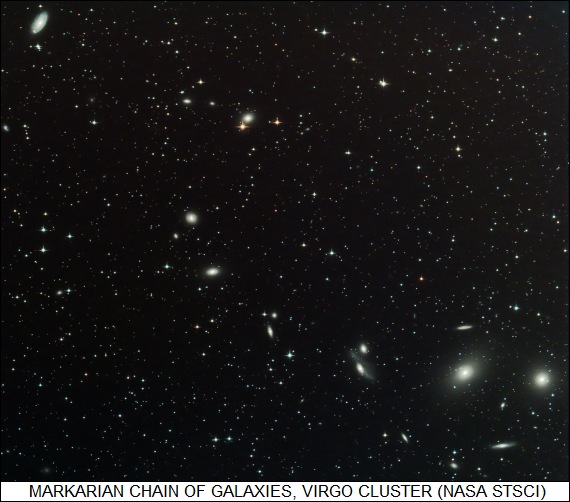
* In a typical cluster of galaxies, the members are separated by distances from ten to a hundred times their own diameter. However, the galaxies in a cluster are in motion and gravitationally attracted to each other, and as mentioned collisions are by no means unusual. Furthermore, such collisions are more likely to be observed at greater distances from the Earth, because the Universe was smaller in the distant past.
Observations of collisions and interactions between such distant galaxies have been observed in some detail. Galaxies with odd narrow, extended features known as "bridges" or "tails" have been known since the 1950s, though they were long ignored since they were uncommon and nobody had a clear idea of what such "rattail" galaxies were.
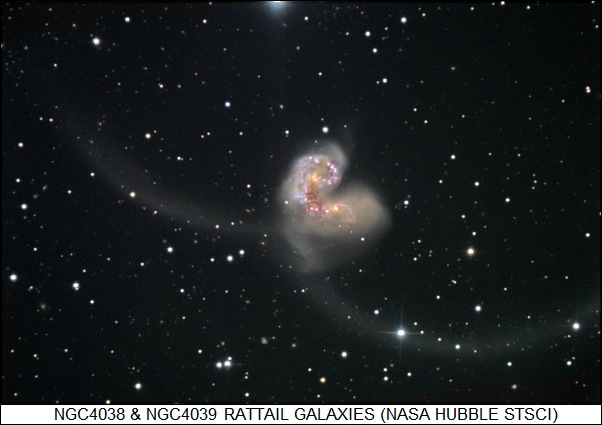
There was something clearly strange about these galaxies, but it wasn't until the 1980s that astronomers realized there were many other galaxies in the Universe where something strange was going on. In 1983, the NASA-Dutch "Infrared Astronomical Satellite (IRAS)" mapped the sky in the infrared region of the spectrum, and found many galaxies that were far brighter in the infrared than they were in the visible region of the spectrum. These were clearly starburst galaxies, with a wave of star formation very possibly triggered by collisions with other galaxies.
Furthermore, infrared images of some elliptical galaxies, which are generally very uniform in their structure, showed some of them had faint shells of luminous matter, apparently composed of stars that had been obtained in a collision with another galaxy. A few ellipticals even seemed to have cores and shells that rotated in opposite directions, suggesting a collision.
By that time, computer models were available that demonstrated how tidal forces between galaxies could produce the bridges and tails initially observed decades before. Improved models showed that two galaxies approaching each other would tend to rapidly spin together and merge.
Interestingly, since galaxies are mostly empty space, if two galaxies in a collision are moving rapidly relative to each other they may pass right through each other with little disruption. If they are moving slowly, however, tidal forces will have time to do considerable damage. In any case, collisions between galactic molecular clouds lead to rapid star formation.
BACK_TO_TOP* Galaxies evolve over time, and in the distant past there were galaxies with a level of core activity unheard of in the present. Such galaxies are known as "quasars".
In 1962, the Australian astronomer Cyril Hazard (1928:2025), then at the University of Sydney, was using the new radio telescope at Parkes to observe a powerful radio source that had been discovered in the constellation Virgo. Although the radio telescope technology available at the time was not accurate enough to pin down the exact location of the source by itself, Hazard and his colleagues were able to use an eclipse or "occultation" of the source by the Moon to determine its exact coordinates.
The coordinates matched those of a relatively bright, starlike object with the catalog designation of "3C 273". An astronomer at the Mount Palomar Observatory in California named Maarten Schmidt (1929:2022) then obtained an optical spectrum of the object. The spectrum appeared totally baffling at first, but Schmidt was able to identify the spectral lines of hydrogen, shifted way down in the light spectrum. He concluded that the object was moving rapidly away from the Earth, and that its spectrum was redshifted by 16% as a result.
It was known at the time that the Universe is expanding, and that the farther away an object was, the faster its recession velocity from the Earth and the greater the redshift. The redshift of an object could be used as a rough estimate of its distance, and by that measure 3C 273 seemed to be about two billion light-years away. It was the first "quasistellar radio source" or "quasar" to be identified. More were quickly discovered, all with strong redshifts that implied they were very far away.
However, they were extremely bright, roughly a thousand times brighter than galaxies observed at comparable distances, and more interestingly their brightness varied rapidly, sometimes changing by an order of magnitude in days. This meant that the source of energy for the quasars had to be compact, since no luminous object can completely turn itself off or on any faster than the time it takes light to travel from one side to another. The active region couldn't be more than a light-week across.
These constraints suggested to some astrophysicists that the quasars couldn't be as far away as their redshifts implied, that they were essentially local and nowhere near as energetic as they seemed. Many astrophysicists suggested that the redshifts were due to the effects of strong gravitational fields in the cores of the quasars, not the expansion of the Universe. There was even an amusing fringe notion that they might be fusion-powered starships, all leaving the Milky Way to escape the apocalyptic "core explosion" that some astrophysicists believed might be taking place. None of these speculations were taken very seriously, least of all the starship model; the evidence gradually convinced most astronomers that the quasars were as far away as they seemed.
* Thousands of quasars have been discovered since 3C 273, with some of them having redshifts as high as 500%. They produce so much energy that they are easy to spot, despite their great distances. Interestingly, they are bright all through the electromagnetic spectrum, and in fact their radio output is only a relatively small part of their output. Some astronomers suggested that the name "quasar", implying a radio source, was inappropriate, and proposed the term "quasistellar object (QSO)". However, "quasar" had a catchy ring to it and had penetrated pop culture anyway, so there was no getting rid of it.
Despite their brightness, quasars are so far away that no Earth-based telescope can show them as a much more than a starlike point of light. Observations show that they were very common in the early Universe, with the number increasing by a factor of a thousand at a redshift of 200%, equivalent to a distance of about 10 billion light-years. They are scarce in the furthest and most ancient reaches of the Universe, indicating that it took a certain amount of time for them to form. Their rates of energy production are astounding.
Over the decades, a consensus has gradually arisen that they are the active cores of distant galaxies. About 1% of galaxies observed in the relatively near and modern Universe are active galaxies, as discussed above, and these galaxies have some features of quasars but are much less energetic. For example, observations of the giant elliptical galaxy M87, in the Virgo Cluster and about 50 million light-years away, demonstrate some core activity with a spectral signature much like that of a quasar if a thousand times fainter. It is plausible that M87 was much more active in the distant past, or in other words it was a quasar at one or more times in its history.
Some poor telescopic images obtained in the 1970s did show that some quasars had fuzzy halos that might be the outer regions of galaxies. Astronomers hoped the Hubble Space Telescope would be able to obtain better images of quasars, using a coronagraph that blank out the central region of a quasar so the surrounding details, if any, could be seen. Unfortunately, after the Hubble was put into orbit, it was found to have flawed optics; the fixes made later to the telescope eliminated the coronagraph, hobbling quasar observations. Astronomers made do with what they had, obtaining multiple images of 34 quasars and then using software to blank out the bright central region of the objects from the images. About three-quarters of the images displayed the faint imprint of a host galaxy, with half being spirals and half being ellipticals. The images were not adequate to show if the other quarter had a surrounding galaxy or not.
* Not long after the discovery of quasars, astrophysicists Edwin Salpeter (1924:2008) and Yakov B. Zel'dovich (1914:1987) suggested that the engine driving quasar energy production was mass falling into an ultramassive black hole, as big as 100 million Suns, with this theory becoming widely accepted. This process converts 40% of the mass into energy and is about 400 times more efficient than thermonuclear fusion. Competing models ended up forming ultramassive black holes in the end anyway. Observations of the core of the elliptical galaxy M87 showed a source that was blueshifted on one side and redshifted on the other, spinning so fast that the central object had to be compact and enormous. This was consistent with an accretion disk spinning around a black hole of about 3 billion Suns.
However, the ultramassive black hole model does have its difficulties. An ultramassive black hole would quickly sweep up all the stars and gas in its neighborhood, go quiet until another star or gas cloud fell into the trap, radiate for a short time, and then go quiet again. Nobody's certain how long quasars live, with a statistical analysis of the distribution of quasars versus time suggesting that they are only active for about 10 million years, not long on the cosmic scale of things. This is still a long time to be producing energy at the rate observed in quasars.
Many of the quasars imaged by the Hubble Space Telescope that seemed to have external galaxies also seemed to be undergoing collisions with other galaxies that would result in starburst activity. Starburst galaxies are bright, but not as bright as quasars. No starburst galaxies seem to be funneling mass into a central black hole. If they were, they might be as bright as, and indistinguishable from, quasars. The collision theory helps explain why quasars were more common in the early Universe, since ten billion years ago the Universe was 30 times denser.
Even when they were common, quasars were outnumbered by "inactive" galaxies by about a thousand to one. That implied either that ultramassive black holes are uncommon, or that they don't become active except under unusual circumstances. Hubble observations have shown that of 27 nearby galaxies, 11 of them seem to have a supermassive black hole or some other less-likely mass concentration in the core. Astronomers believe they are probably common, so the notion that they only become active engines under special circumstances is popular.
Incidentally, the Hubble observations also provided definitive proof that quasar redshifts are due to the expansion of the Universe. The theory that the redshifts were due to the effects of the strong gravitational fields of the central mass implied that the redshift of the galaxy around the core of the quasar would not be as great, but the observations showed the same redshifts for both the core and the outer regions.
Although ultramassive black holes are seen as the best model for the central engine of quasars, the proof is somewhat indirect, and even if ultramassive black hole theory is correct, much remains to be determined about the precise mechanisms. The huge new ground-based telescopes of the 21st century will probably do much to resolve the question of quasars.
BACK_TO_TOP